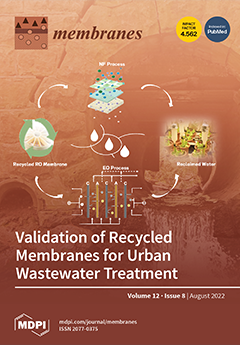As it is used in all aspects of human life, water has become more and more polluted. For the past few decades, researchers and scientists have focused on developing innovative composite adsorbent membranes for water purification. The purpose of this research was to synthesize a novel composite adsorbent membrane for the removal of toxic pollutants (namely heavy metals, antibiotics and microorganisms). The as-synthesized chitosan/TiO
2 composite membranes were successfully prepared through a simple casting method. The TiO
2 nanoparticle concentration from the composite membranes was kept low, at 1% and 5%, in order not to block the functional groups of chitosan, which are responsible for the adsorption of metal ions. Nevertheless, the concentration of TiO
2 must be high enough to bestow good photocatalytic and antimicrobial activities. The synthesized composite membranes were characterized by Fourier transform infrared spectroscopy (FTIR), X-ray diffraction (XRD), scanning electron microscopy (SEM), thermogravimetric analysis (TGA) and swelling capacity. The antibacterial activity was determined against four strains,
Escherichia coli, Citrobacter spp.,
Enterococcus faecalis and
Staphylococcus aureus. For the Gram-negative strains, a reduction of more than 5 units log CFU/mL was obtained. The adsorption capacity for heavy metal ions was maximum for the chitosan/TiO
2 1% composite membrane, the retention values being 297 mg/g for Pb
2+ and 315 mg/g for Cd
2+ ions. These values were higher for the chitosan/TiO
2 1% than for chitosan/TiO
2 5%, indicating that a high content of TiO
2 can be one of the reasons for modest results reported previously in the literature. The photocatalytic degradation of a five-antibiotic mixture led to removal efficiencies of over 98% for tetracycline and meropenem, while for vancomycin and erythromycin the efficiencies were 86% and 88%, respectively. These values indicate that the chitosan/TiO
2 composite membranes exhibit excellent photocatalytic activity under visible light irradiation. The obtained composite membranes can be used for complex water purification processes (removal of heavy metal ions, antibiotics and microorganisms).
Full article






